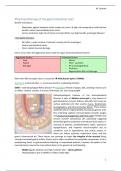Resume
Pharmacology & Pharmacokinetics: VOLLEDIGE Samenvatting deel: CASTEELS
- Établissement
- Katholieke Universiteit Leuven (KU Leuven)
VOLLEDIGE samenvatting van het moeilijkste vak van 1e master BMW in Leuven. Bewezen resultaten, 18/20! Tips bij dit vak: leer om te begrijpen en maak bovenop deze samenvatting flashcards, herhalen herhalen herhalen is de boodschap. veel succes!
[Montrer plus]



